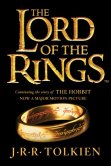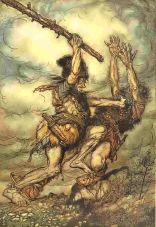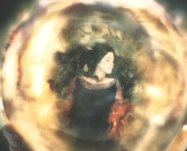Unpopular opinion alert: I’m not the biggest fan of Tolkien — specifically, of The Lord of the Rings.

I know this is essentially heresy to admit to the teeming hordes of guys and gals who, like me, adore the fantasy genre. But, alas, ’tis true that I am not on the side of Mr. J.R.R. Despite this general dislike, I’m relatively fair-minded and can acknowledge that The Lord of the Rings is one of the most recognizable works of the fantasy genre — even with more modern series such as George R.R. Martin’s A Song of Ice and Fire, The Lord of the Rings is the ultimate poster-child for marketing fantasy to a mainstream audience.
That being said: I don’t think that Tolkien “invented” modern fantasy as we know it. This, I’m sure, is also going to rankle even more people, especially given that many would argue that The Lord of the Rings “created ‘fantasy’ as a marketing category” (Yolen, After the King: Stories in Honour of J.R.R. Tolkien), despite the fact that fantasy existed long before Tolkien published his trilogy.
But I don’t want to talk about the myriad of works previous to Tolkien…I actually just want to talk about one: Der Ring des Nibelungen, or The Ring of the Nibelung by Richard Wagner.
 For those of you unfamiliar with German opera: The Ring Cycle, as it’s frequently called, is a cycle of four opera seria (dramatic operas) written about a century before Tolkien, that’s loosely based on characters from Germanic and Norse mythological sagas, specifically the Volsunga saga and the Nibelungenlied. It’s got giants, dwarves, gods, forbidden romances, action, adventure — basically everything you could ever want from an epic fantasy story, and all across four operas which, when performed, are staged over the course of several days.
For those of you unfamiliar with German opera: The Ring Cycle, as it’s frequently called, is a cycle of four opera seria (dramatic operas) written about a century before Tolkien, that’s loosely based on characters from Germanic and Norse mythological sagas, specifically the Volsunga saga and the Nibelungenlied. It’s got giants, dwarves, gods, forbidden romances, action, adventure — basically everything you could ever want from an epic fantasy story, and all across four operas which, when performed, are staged over the course of several days.
Even with all of those elements, at the very centre of this massive tale is a magic ring fashioned from Rhine gold that allows its bearer to rule the world.
Sound familiar?
One Ring to rule them all, One Ring to find them
One Ring to bring them all and in the darkness bind them
It should, given that both narratives have a high-stakes “MacGuffin” at their centre in the form of all-powerful, solid gold rings. In fiction, a MacGuffin is a plot device in the form of some goal, desired object, or other motivator that drives the plot of said fictional work.
But the parallels of these magic rings goes further: both are created via some kind of dark magic-figure — Sauron in Tolkien; Alberich in Wagner — and, thus, have the unfortunate repercussion of affecting the wearer. Alberich himself says: “the lord of the ring as [sic] the slave of the ring.”
In other words: don’t wear that thing, it’s cursed.
 One of the best illustrations of this in Tolkien is the effect the One Ring has upon the creature Gollum, whose true name was Sméagol. He and his relative, Déagol, found the Ring in the riverbed and Sméagol fell immediately under the Ring’s influence, demanding it from his relative; when Déagol refused, Sméagol strangled him. Sméagol later retreated to a deep cavern in the Misty Mountains, where he lived for centuries (The Fellowship of the Ring).
One of the best illustrations of this in Tolkien is the effect the One Ring has upon the creature Gollum, whose true name was Sméagol. He and his relative, Déagol, found the Ring in the riverbed and Sméagol fell immediately under the Ring’s influence, demanding it from his relative; when Déagol refused, Sméagol strangled him. Sméagol later retreated to a deep cavern in the Misty Mountains, where he lived for centuries (The Fellowship of the Ring).
Almost a century earlier, we met Fafner, a giant who gets into a quarrel with his brother, Fasolt, over their treasure, namely the Ring. Their quarrel culminates in Fafner murdering Fasolt by clubbing him to death. From there, he succumbs to the dark power of the ring, transforming into a dragon and retreating into a deep cave to hide with his treasure for centuries (Das Rheingold).
 Tack onto that similarity, the narrative finale that (SPOILERS!) both Rings are returned to the place from which they were made — Mt. Doom in Tolkien; the Rhine River in Wagner — and you’ve got a multi-story overarching plot that isn’t just similar, it’s practically identical. The obvious counterargument would be that they were both drawing from similar Nordic and Germanic mythologies. But the development of the myth that the Ring gives the owner mastery of the world, as well holds a corrupting power that immediately affects the wearer was unique to Wagner, not his inspirational source material.
Tack onto that similarity, the narrative finale that (SPOILERS!) both Rings are returned to the place from which they were made — Mt. Doom in Tolkien; the Rhine River in Wagner — and you’ve got a multi-story overarching plot that isn’t just similar, it’s practically identical. The obvious counterargument would be that they were both drawing from similar Nordic and Germanic mythologies. But the development of the myth that the Ring gives the owner mastery of the world, as well holds a corrupting power that immediately affects the wearer was unique to Wagner, not his inspirational source material.
What I find most interesting in terms of the similarities of these two works is that, beneath the mythology, they’re both incredibly modern stories: fantastical ideations of the premise that possession of a single piece of technology could endow even the lowliest of peons with god-like amounts of power. Both Wagner’s Ring and Tolkien’s One Ring are more akin to atomic bombs than they are to, say, the weaponry of Norse mythology. After all, no human could possess the hammer of Thor; none but Zeus could wield the thunderbolt. But anyone can possess the Ring — a mythological nuance created by Wagner and appropriated by Tolkien, who didn’t even have the grace to acknowledge such, saying only:
“Both rings were round, and there the resemblance ceased.”
Excuse me while I pause to take a moment to say:

Okay, granted, there is the possibility that Tolkien’s remarks were in connection to the unfortunate association of Wagner’s music with the Nazi party, but that doesn’t excuse the fact that The Lord of the Rings was quite blatantly appropriating Nibelung, even beyond the shiny gold MacGuffin of doom at its narrative core.
“… I regard the tale of Arwen and Aragorn as the most important of the Appendices [in The Lord of The Rings]…” (Tolkien, Letter 181)

The romance between Aragorn and Arwen, played up much more in the Peter Jackson films, is something that always made me a little uncomfortable in The Lord of the Rings — people seem to forget that Aragorn and Arwen are related. While the dilution of the line is significant on Aragorn’s side due to mortality of the line of Numenor, she’s still something like his great-aunt x14.
At first, I couldn’t explain why this always bothered me, but then I remembered.
While one of the more famous relationships within Nibelung is the incestuous one between siblings Sigmund and Sieglinde — to be fair, they didn’t know…at first — the one that takes very dramatic centre stage in the final two operas is that of their son, Siegfried, and his aunt, the Valkyrie, Brünnhilde.
 And here is where you can see what I admit to be the ultimate divide, where Tolkien lives truly in the shadow of Wagner’s Ring: Tolkien’s need to cleanse what he saw as the corruption of “the noble northern spirit” by the Nazis. Thus, you have The Lord of the Rings as something softer that Nibelung: what has been aptly called a “mythology without malice.” In Nibelung, the albeit-diluted, but still-incestuous relationship between Siegfried and Brünnhilde ends in spectacularly tragic fashion: he is stabbed, and she rides into a funeral pyre Dido-style to join him in death (Götterdämmerung). Tolkien’s end for his incestuous lovers is one of chaste reward: Aragorn and Arwen live on to have their happy little incest-babies until Aragorn dies of old age and Arwen passes on to join him (The Tale of Aragorn and Arwen).
And here is where you can see what I admit to be the ultimate divide, where Tolkien lives truly in the shadow of Wagner’s Ring: Tolkien’s need to cleanse what he saw as the corruption of “the noble northern spirit” by the Nazis. Thus, you have The Lord of the Rings as something softer that Nibelung: what has been aptly called a “mythology without malice.” In Nibelung, the albeit-diluted, but still-incestuous relationship between Siegfried and Brünnhilde ends in spectacularly tragic fashion: he is stabbed, and she rides into a funeral pyre Dido-style to join him in death (Götterdämmerung). Tolkien’s end for his incestuous lovers is one of chaste reward: Aragorn and Arwen live on to have their happy little incest-babies until Aragorn dies of old age and Arwen passes on to join him (The Tale of Aragorn and Arwen).
Also, don’t forget: both of these heroes received the shards of their male ancestor’s sword and had them reforged. As if one powerful magical object wasn’t enough…
“For Tolkien, myth is a window on an ideal world, both brighter and blacker than our own. For Wagner, it is a magnifying mirror for the average, desperate modern soul” (Ross, The New Yorker)
In Nibelung, the “world-redeeming deed” of the ring’s destruction is performed by Brünnhilde as a final sacrifice upon her own self-built pyre. Fun fact: the character of Hagen tries to stop the  Rhinemaidens reclaiming the Ring and drowns while attempting to retrieve it, much like another character we know (*cough*GOLLUM*cough*). The world of Valhalla collapses in a roar of flame as the gods surrender their power (Götterdämmerung).
Rhinemaidens reclaiming the Ring and drowns while attempting to retrieve it, much like another character we know (*cough*GOLLUM*cough*). The world of Valhalla collapses in a roar of flame as the gods surrender their power (Götterdämmerung).
In Tolkien, this violent act of gods is done by a peace-loving hobbit who wants nothing more than to return to the idyllic comfort of his home far away from where he is; and, ultimately the elves relinquish their dominion peacefully, to restore a world wasted by the dark representation of the gods: Sauron (Return of the King).
By this point, I don’t care if Tolkien was reacting against the association of Wagner’s work with Naziism, there’s no denying that The Lord of the Rings borrows heavily from Der Ring des Nibelungen to the point of appropriation — as a result, I fail to see how it can be called the “beginning” of modern fantasy because, frankly, the honour should be going to Wagner or, at the very least, back to the mythological origins of both works.
In the “Evolution of Fantasy” episode of The Book Table, I make a point of saying that due to my own personal beliefs, I consider mythology a part of the fantasy genre, i.e. I consider it fiction. The primary concern that is brought up with this view is the question of author intent: am I taking into consideration the intention of any author in question as to whether or not they believed what they were writing?
My response was: no, I am trying not to.
I try not to fall into the Romantic school of thought as it pertains to the separation of work and author. I say “Romantic” with a capital-R because I take this term from what I studied of music history: there is a clear change in the consideration of the composer in relation to his work starting around the time of Beethoven who, for many students of classical music, is the “bridge composer” between the Classical Era and the Romantic Era of the genre. It was after Beethoven that composer and work became inextricably linked.
With that regard, I often attempt to separate authors’ personal beliefs from their work; it’s not an easy task and I admit that I don’t always succeed. But in the case of my own attempt to distill and personally define the very broad term “fantasy” into a genre, I choose to allow myself a larger timeline by including mythology, into which category I group religious material old and new.
The very word “myth” derives from the Greek μῦθος (mythos), which simply translates as “story.” There is no connotation as to whether or not the word implies either truth or falseness of the story itself; it is, effectually, a neutral term. And that is how I view mythology: divorced from its (by this point, multiple) authors and neutral in its purpose. To me, it’s just storytelling — and storytelling that invokes much of the inexplicable and fantastical. Ergo: I consider it fiction. Again, it allows me a greater timeline of what I consider “fantasy” in order to see the a larger-scale evolution of the genre.
When Tolkien stole and sanitized Wagner’s Ring, he arguably did only what Joseph Campbell would have said was natural to all human storytellers: propagating the monomyth. For those of you unfamiliar with narratology — or, at the very least, never had to read Campbell’s The Hero with a Thousand Faces in school — the monomyth is also known as the hero’s journey, and was described by Campbell as such:
“A hero ventures forth from the world of common day into a region of supernatural wonder: fabulous forces are there encountered and a decisive victory is won: the hero comes back from this mysterious adventure with the power to bestow boons on his fellow man.”
Straightforward and simple. But, even more importantly, a story that Campbell argued was the only story: a megamyth of mankind, told in multiple forms and colours since humanity began telling stories. Whether or not I entirely agree with this, it is a theory I cannot deny has influenced my personal backlash against The Lord of the Rings in this essay. And I also cannot deny that both the vehemence of my argument and the intensity of my irritation would not be so great were not Tolkien so widely and loudly touted as some creator of fantasy who cannot be faulted or touched.
Sorry, Tolkien, in my opinion you’re just too many years too late for me to hold you up as some creator of modern fantasy.
**The author would like to note that she does kind of enjoy The Hobbit, despite not being the biggest fan of its successor.**
This post was originally published on February 22nd on backroomwhispering.com.
One thought on “In the Shadow of ‘The Ring’”